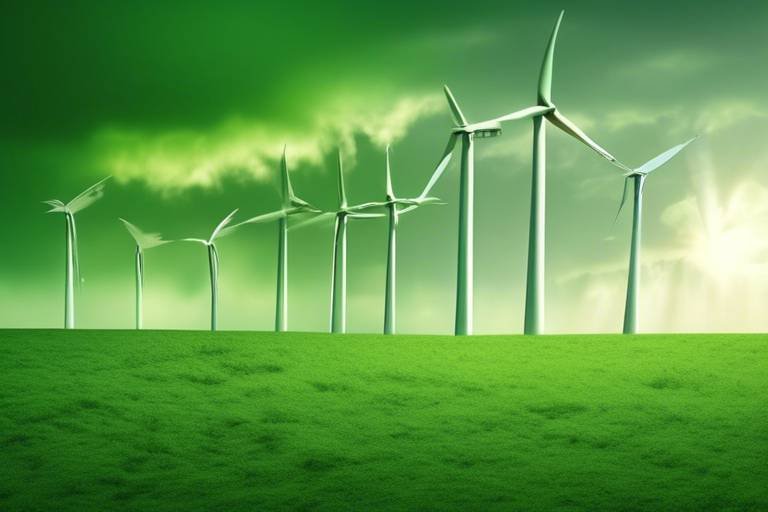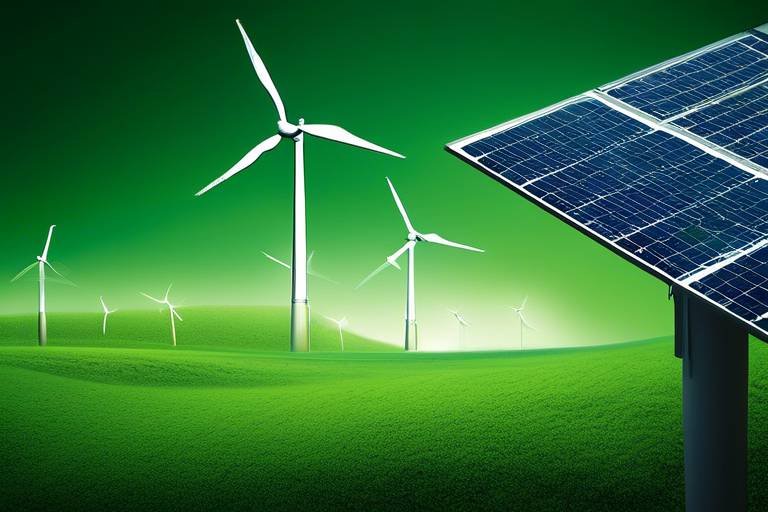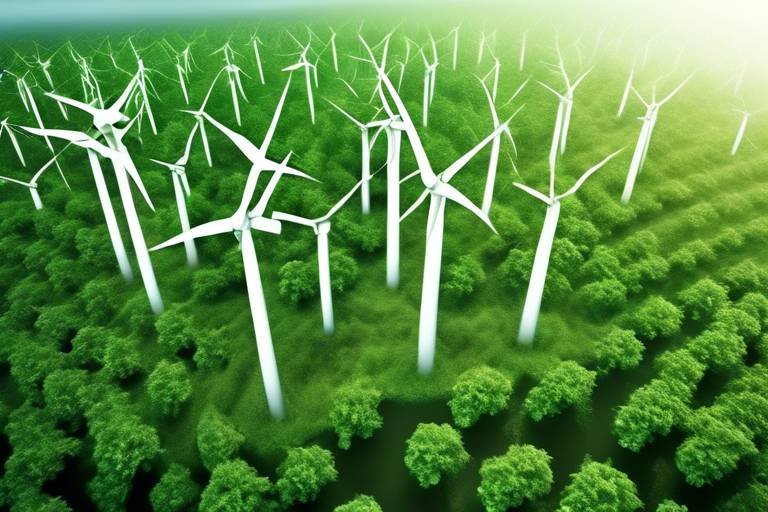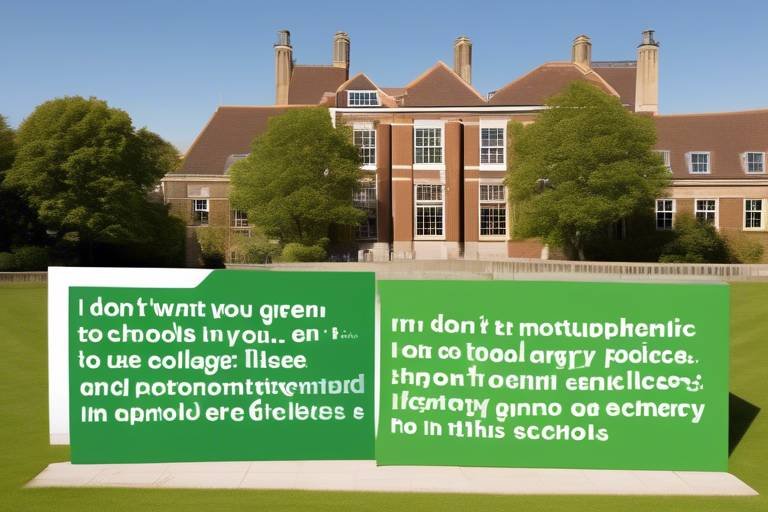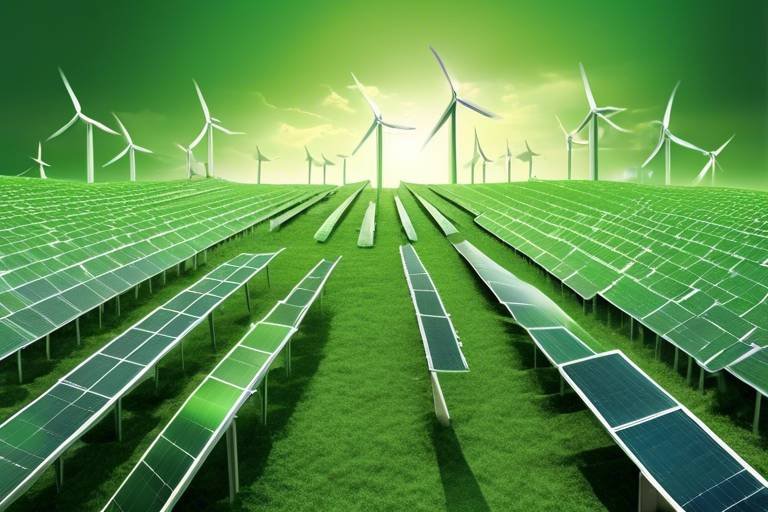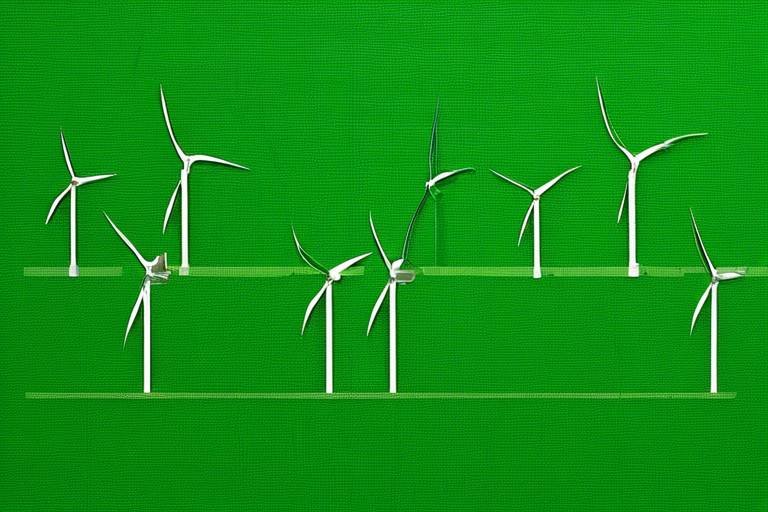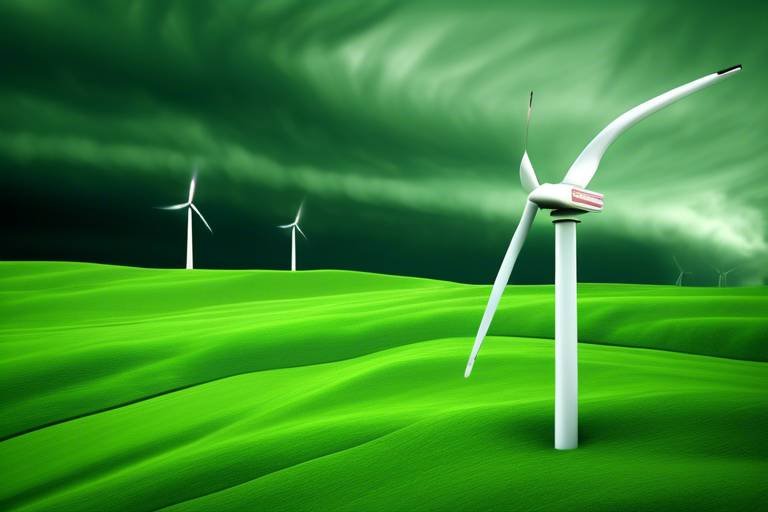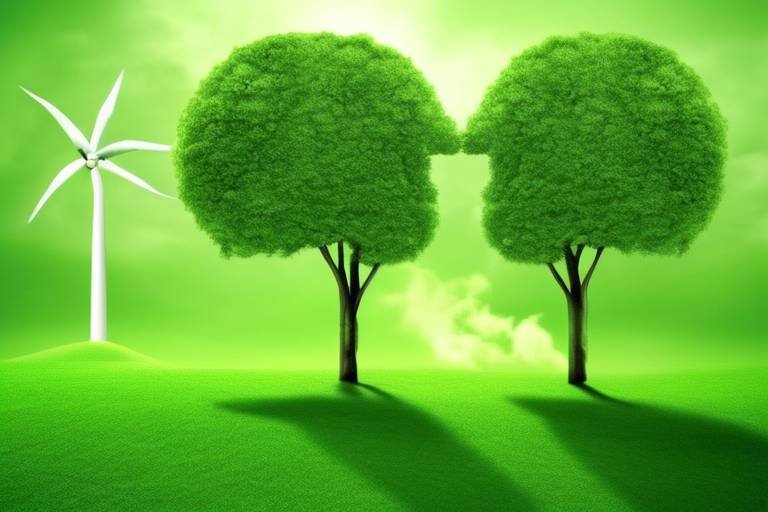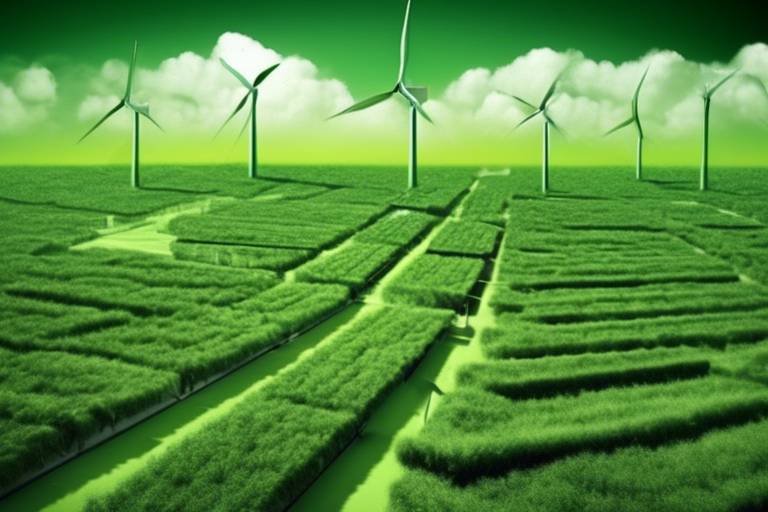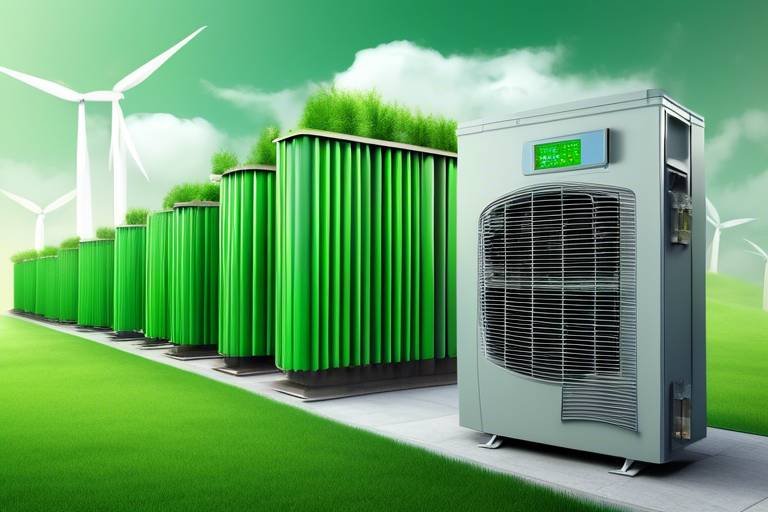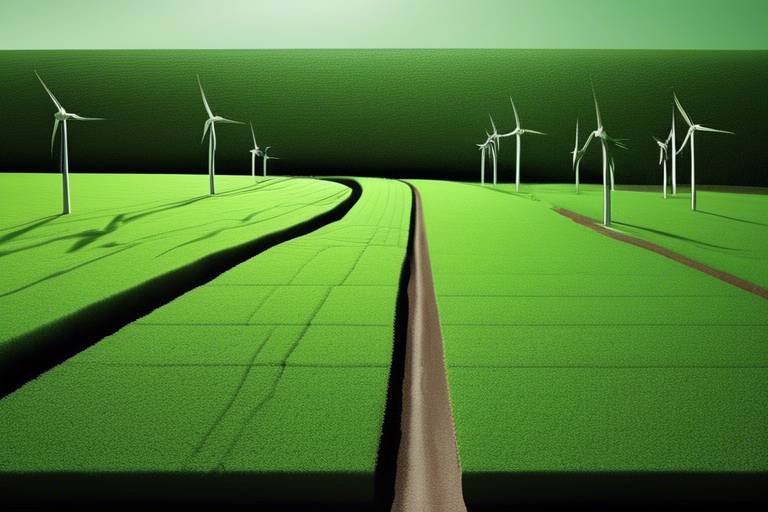Decoding the Science Behind Wind Turbines
Wind energy is not just a buzzword; it's a crucial player in the quest for sustainable power. As we dive into the world of wind turbines, we unravel the fascinating science that transforms the invisible force of wind into usable electricity. Have you ever stood on a windy day and felt the gusts pushing against you? That's energy in motion, and with the right technology, it can be harnessed to power our homes, schools, and businesses. In this article, we will explore the fundamental principles of wind turbines, their components, and the cutting-edge technology that enables them to convert wind energy into electricity efficiently and sustainably.
Understanding wind energy is crucial for grasping how wind turbines operate. Wind is essentially air in motion, created by the uneven heating of the Earth's surface by the sun. Warm air rises, and cooler air rushes in to take its place, creating currents that we can harness for energy. The beauty of wind energy lies in its abundance and renewability; unlike fossil fuels, it won't run out as long as the sun shines and the Earth spins. So, how do we capture this energy? That's where wind turbines come in, acting like giant fans that convert kinetic energy into mechanical energy, which is then transformed into electrical energy.
Wind turbines are marvels of engineering, consisting of several key components, each playing a vital role in the energy conversion process. The primary parts include:
- Blades: The wings of the turbine that capture wind energy.
- Nacelle: The housing that contains the turbine's mechanical components.
- Tower: The structure that elevates the turbine to capture stronger winds.
- Rotor: The assembly of blades and hub that rotates to generate energy.
Each of these components works in harmony to maximize efficiency and ensure that the turbine operates smoothly, even in varying wind conditions.
The blades are critical for capturing wind energy, and their design is nothing short of genius. Think of them as the wings of an airplane, expertly shaped to optimize lift and minimize drag. The aerodynamic design of turbine blades involves careful consideration of their shape and angle, which allows them to catch the wind effectively. When the wind blows, it creates lift on one side of the blade and lower pressure on the other, causing the rotor to spin. This spinning motion is what ultimately drives the generator to produce electricity.
When it comes to blade construction, the choice of materials is paramount. Common materials include fiberglass, carbon fiber, and sometimes even wood. These materials are selected for their strength, durability, and lightweight properties, ensuring that the blades can withstand harsh weather conditions while remaining efficient. For instance, fiberglass is often used because it's both strong and flexible, allowing the blades to bend slightly in high winds without breaking.
Now, let's talk about blade length. Longer blades can capture more wind energy, but they also present engineering challenges. The relationship between blade length and turbine efficiency is a complex dance; while longer blades can harness more energy, they require stronger materials and more robust designs to handle the increased stress. It's a balancing act that engineers must navigate to create turbines that are both efficient and reliable.
The nacelle is often referred to as the heart of the wind turbine. It houses the key mechanical components, including the gearbox, which converts the rotational energy from the blades into usable electrical power. The gearbox is essential for increasing the rotational speed to match the generator's requirements. Without this conversion, the energy captured by the blades would be rendered useless.
Not all wind turbines are created equal! Various types exist, each tailored for specific applications and environments. The two main types are horizontal-axis and vertical-axis turbines, each with unique advantages that make them suitable for different settings.
The most common type of wind turbine, horizontal-axis turbines, are widely used in large wind farms. Their design features two or three blades mounted on a tall tower, allowing them to capture high-altitude winds. These turbines are known for their efficiency and are often found in open fields where wind is abundant.
On the other hand, vertical-axis turbines offer distinct benefits in urban environments. Their design allows them to capture wind from any direction, making them ideal for locations where wind patterns are unpredictable. They are generally quieter and less visually intrusive, which can be a significant advantage in populated areas.
Wind farms play a crucial role in harnessing wind energy on a large scale. These installations consist of multiple turbines working together to generate substantial amounts of electricity. The design and operation of wind farms are carefully planned to maximize efficiency and minimize environmental impact.
Choosing the right location for wind farms is essential for maximizing efficiency. Factors influencing site selection include wind speed, land use, and proximity to power grids. The optimal layout for turbine placement can significantly affect energy output, ensuring that each turbine operates at peak performance.
While wind energy is considered green, wind farms can affect local ecosystems. It's vital to analyze the environmental considerations and implement mitigation strategies to minimize negative impacts. This includes assessing the impact on wildlife, particularly birds and bats, and ensuring that the construction and operation of wind farms align with conservation efforts.
As we wrap up this exploration of wind turbines, let's tackle some common questions that people often have:
- How do wind turbines work? Wind turbines convert kinetic energy from the wind into mechanical energy, which is then transformed into electrical energy through a generator.
- What are the main types of wind turbines? The two primary types are horizontal-axis wind turbines and vertical-axis wind turbines, each suited for different applications.
- Are wind farms harmful to the environment? While wind energy is renewable, wind farms can impact local ecosystems. However, with proper planning and mitigation, these effects can be minimized.

The Basics of Wind Energy
Understanding wind energy is crucial for grasping how wind turbines operate. Wind energy is essentially the kinetic energy produced by the movement of air in the Earth's atmosphere. This movement is primarily caused by the uneven heating of the Earth's surface by the sun, resulting in areas of high and low pressure. When air moves from high-pressure areas to low-pressure areas, it creates wind. The strength and direction of the wind can vary greatly depending on numerous factors, including geographic features, weather conditions, and time of year.
To put it simply, wind is like a giant river flowing through the atmosphere, and just like we can harness the flow of water to generate electricity, we can also harness the flow of air. This is where wind turbines come into play. They are designed to capture the energy from the wind and convert it into electricity, making them a vital component of the renewable energy landscape.
Wind energy is not only abundant but also sustainable. It’s one of the cleanest forms of energy available, producing no greenhouse gas emissions during operation. However, understanding how to effectively harness this energy requires an appreciation of the various factors that influence wind patterns. For instance, the topography of an area can significantly impact wind flow. Mountains, valleys, and bodies of water all play a role in shaping local wind conditions.
In addition to geographical features, climate plays a significant role in wind energy potential. Regions with consistent and strong winds, such as coastal areas and open plains, are often ideal locations for wind farms. Conversely, areas with turbulent or erratic wind patterns may not be suitable for large-scale wind energy projects. It's also worth noting that wind energy production can fluctuate throughout the day and year, making it essential to have a reliable energy storage or backup system in place.
To better understand the dynamics of wind energy, consider the following factors:
- Wind Speed: The speed at which the wind blows directly affects the amount of energy that can be generated. Generally, wind speeds between 12 to 25 mph are optimal for wind turbines.
- Wind Direction: The direction of the wind can influence the placement of turbines to ensure they are positioned to capture the maximum amount of wind energy.
- Seasonal Variations: Wind patterns can change with the seasons, impacting energy production. For example, some regions may experience stronger winds in the winter months.
In summary, wind energy is a powerful and sustainable resource that can be harnessed through the use of wind turbines. By understanding the basic principles of wind formation, the importance of location, and the factors that influence wind patterns, we can better appreciate how this renewable energy source can contribute to a greener future.

Components of a Wind Turbine
Wind turbines are fascinating machines that transform the invisible force of wind into usable energy. To appreciate how they work, it’s essential to understand their key components. Each part plays a significant role in the overall functionality and efficiency of the turbine. Let's break down these components, starting from the top and working our way down.
The most recognizable part of a wind turbine is its blades. These long, aerodynamic structures are designed to capture wind energy. When the wind blows, it creates lift, much like how an airplane wing operates. The blades are typically made from lightweight yet durable materials, allowing them to withstand harsh weather conditions while maximizing energy capture. The shape and angle of the blades are meticulously engineered to optimize performance, which we will delve into further in the next subsection.
Next, we have the nacelle, which is essentially the brain of the turbine. Located at the top of the tower, the nacelle houses crucial components such as the gearbox, generator, and control systems. The gearbox is particularly important as it converts the slow rotational energy generated by the blades into faster rotational energy that the generator can use to produce electricity. Without this conversion, the energy captured by the blades would not be usable.
The tower is another vital component, providing the necessary height for the turbine to capture stronger winds that are typically found at higher altitudes. Towers can be made from steel, concrete, or a combination of materials, and their height can vary significantly depending on the design of the wind farm and the specific site conditions. Taller towers allow for greater energy capture, but they also require careful engineering to ensure stability and safety.
The rotor is the assembly of the blades and the hub that connects them to the nacelle. It’s the part that spins when wind hits the blades, initiating the energy conversion process. The rotor's design is crucial; it must be balanced and aligned correctly to ensure efficient operation. A well-designed rotor can significantly enhance the overall performance of the wind turbine.
Here’s a quick overview of the main components of a wind turbine:
| Component | Function |
|---|---|
| Blades | Capture wind energy and convert it into rotational energy. |
| Nacelle | Houses the gearbox, generator, and control systems. |
| Tower | Supports the nacelle and blades, elevating them to capture stronger winds. |
| Rotor | Connects the blades to the nacelle and facilitates energy conversion. |
Understanding these components is just the beginning. Each part works in harmony to ensure that wind turbines operate efficiently and effectively. As we continue to explore the technology behind wind turbines, we will see how innovations in design and materials are pushing the boundaries of what these incredible machines can achieve.
- What is the average lifespan of a wind turbine? Most wind turbines have a lifespan of about 20 to 25 years, depending on maintenance and environmental conditions.
- How much energy can a wind turbine produce? The energy output of a wind turbine varies, but a typical turbine can generate between 1.5 to 3 megawatts of power.
- Are wind turbines noisy? While they do produce some noise, modern turbines are designed to minimize sound levels, making them less intrusive than older models.

Blades and Aerodynamics
When it comes to wind turbines, the blades are the unsung heroes, silently capturing the power of the wind and converting it into energy. But how do they do this? The answer lies in the fascinating world of aerodynamics. Just like an airplane wing, turbine blades are designed to harness the wind's kinetic energy efficiently. Their shape, angle, and surface texture all play critical roles in how effectively they can capture wind energy.
The design of a wind turbine blade is not just a matter of aesthetics; it's a complex interplay of physics and engineering. Blades are typically long and slender, resembling giant feathers, which allows them to slice through the air with minimal resistance. This design is crucial because the blades need to create a difference in air pressure on either side to generate lift. In essence, as wind flows over the curved surface of the blade, it travels faster than the air moving beneath it, creating a pressure drop that lifts the blade and, consequently, the entire rotor.
One of the most important factors in blade design is the angle of attack, which refers to the angle between the blade and the oncoming wind. If this angle is too steep, the blade can stall, losing its efficiency. Conversely, if the angle is too shallow, it won’t capture enough wind energy. Engineers meticulously calculate the optimal angle of attack to ensure maximum energy capture while minimizing drag. This delicate balance is what separates a good wind turbine from a great one.
To put it in perspective, think of the blades as the sails of a ship. Just as sails catch the wind to propel a vessel forward, turbine blades capture wind energy to turn the rotor, which ultimately generates electricity. The efficiency of this energy conversion process hinges on the blade's design and aerodynamics.
Moreover, the material used for blades is equally important. Most turbine blades are made from composite materials, which combine strength with lightweight properties. This is essential because lighter blades can spin faster and generate more energy. However, they also need to withstand harsh weather conditions, such as high winds and extreme temperatures. Engineers often conduct extensive testing to ensure that the materials used can endure these challenges while maintaining performance.
In summary, the interplay of is a critical aspect of wind turbine technology. From their carefully calculated angles to the materials used in their construction, every detail is optimized to maximize energy capture from the wind. Understanding these principles not only highlights the ingenuity behind wind energy technology but also underscores its potential as a sustainable energy source for the future.
- What materials are commonly used for wind turbine blades?
Wind turbine blades are typically made from composite materials, such as fiberglass and carbon fiber, due to their strength and lightweight properties.
- How does the angle of attack affect wind turbine performance?
The angle of attack is crucial for optimizing lift and minimizing drag. An improper angle can lead to inefficiencies or stalling of the blades.
- Why are longer blades more efficient?
Longer blades can capture more wind energy due to their larger surface area, but they also require careful engineering to manage stresses and maintain performance.

Material Considerations
When it comes to wind turbine blades, the choice of materials is not just a trivial detail; it’s a critical factor that can make or break the performance and longevity of the turbine. The materials used must withstand harsh environmental conditions while maintaining efficiency and structural integrity. Typically, wind turbine blades are made from a variety of materials, each with its own set of advantages and challenges.
One of the most common materials used in blade construction is fiberglass. This composite material is lightweight yet incredibly strong, making it ideal for creating long, aerodynamic blades that can capture maximum wind energy. Fiberglass blades are also resistant to corrosion, which is crucial given the often harsh conditions in which wind turbines operate.
Another material gaining popularity is carbon fiber. While more expensive, carbon fiber offers superior strength-to-weight ratios compared to fiberglass. This means that blades can be designed longer and thinner without compromising durability. The increased efficiency from longer blades can lead to higher energy output, making carbon fiber an attractive option for advanced turbine designs.
However, it’s not just about strength and weight. The environmental impact of materials is also a growing concern. Many manufacturers are now exploring bio-based composites that reduce reliance on fossil fuels and minimize carbon footprints. These materials not only help in making the blades more sustainable but also appeal to a growing market of environmentally conscious consumers.
Here’s a brief table summarizing the common materials used in wind turbine blades and their properties:
| Material | Strength | Weight | Cost | Environmental Impact |
|---|---|---|---|---|
| Fiberglass | High | Lightweight | Moderate | Moderate |
| Carbon Fiber | Very High | Very Lightweight | High | Moderate |
| Bio-based Composites | Moderate | Lightweight | Moderate | Low |
In addition to the primary materials, the design of the blades also plays a significant role in their overall performance. Engineers must consider factors such as blade length, shape, and angle to optimize energy capture. Longer blades can harness more wind energy, but they also require more robust materials to handle the increased stress. This balancing act between length and material strength is a key consideration in turbine design.
Ultimately, the choice of materials for wind turbine blades is a complex decision that involves trade-offs between strength, weight, cost, and environmental impact. As technology advances and the demand for renewable energy grows, we can expect to see even more innovative materials being developed to enhance the efficiency and sustainability of wind turbines.
- What materials are commonly used in wind turbine blades?
Wind turbine blades are typically made from fiberglass, carbon fiber, and increasingly from bio-based composites. - Why is material choice important for wind turbine blades?
The right materials ensure strength, durability, and efficiency, which are crucial for optimal energy capture and performance. - How do longer blades affect turbine performance?
Longer blades can capture more wind energy, leading to higher efficiency, but they also require stronger materials to support the added stress. - Are there environmentally friendly options for turbine blades?
Yes, manufacturers are exploring bio-based composites that reduce environmental impact while maintaining performance.

Blade Length and Efficiency
When it comes to wind turbines, the length of the blades is a game changer. Think of the blades as the wings of a bird; the longer they are, the more air they can capture, and consequently, the more energy they can generate. It's a straightforward concept, but the implications are profound. Longer blades can sweep through a larger volume of wind, which translates to increased energy production. However, this isn't just about making the blades longer and calling it a day. There are engineering challenges that come into play, particularly concerning structural integrity and material strength.
To put this into perspective, let’s consider how blade length impacts efficiency. A turbine with longer blades can harness wind energy more effectively, especially in areas with lower wind speeds. This is because the blades need to move through a greater mass of air to generate the same amount of energy as shorter blades would in stronger winds. In fact, studies have shown that for every additional meter in blade length, there can be a significant percentage increase in energy capture. This relationship is illustrated in the table below:
| Blade Length (meters) | Energy Capture (kWh) | Efficiency (%) |
|---|---|---|
| 30 | 1200 | 25 |
| 40 | 1800 | 35 |
| 50 | 2500 | 45 |
However, longer blades also mean that the turbine must be designed to withstand greater forces. As the length increases, so does the torque that the blades exert on the turbine structure. Engineers must strike a balance between maximizing blade length for energy capture and ensuring that the turbine can handle the stresses involved without compromising safety or performance. This is where advanced materials and innovative designs come into play, allowing for longer blades that are both lightweight and strong.
Moreover, the efficiency of wind turbines is not solely determined by blade length. Factors such as the angle of attack, the shape of the blades, and even the wind conditions all play critical roles. For instance, blades that are too long may face challenges in high-wind conditions, leading to potential damage or the need to shut down the turbine to prevent failure. So, while longer blades can lead to enhanced efficiency, they must be carefully engineered to perform optimally across a range of conditions.
In conclusion, the relationship between blade length and efficiency is a fascinating interplay of physics, engineering, and environmental considerations. As technology advances, we can expect to see even more innovative solutions that push the boundaries of how we harness wind energy. The quest for longer, more efficient blades is not just about maximizing output; it’s about creating a sustainable future powered by renewable energy.
- What is the ideal blade length for wind turbines? The ideal blade length varies depending on the location and wind conditions. Generally, longer blades are more efficient, but they must be designed to withstand environmental stresses.
- How does blade length affect turbine performance? Longer blades can capture more wind energy, especially in low-wind areas, leading to higher energy production and efficiency.
- Are there any downsides to longer blades? Yes, longer blades can face engineering challenges, including increased torque and the risk of damage in high-wind conditions.

Nacelle and Gearbox
The nacelle is a vital component of a wind turbine, often likened to the brain of the system. It houses the key mechanical elements that enable the conversion of wind energy into usable electricity. Nestled atop the tower, the nacelle is designed to withstand harsh environmental conditions while providing easy access for maintenance. Inside, you'll find the gearbox, which plays a crucial role in transforming the rotational energy generated by the turbine's blades into electrical energy. But how does it all work together?
When the wind blows, it causes the turbine blades to rotate. This rotational motion is transferred to the gearbox, which adjusts the speed of the rotation. Typically, the blades rotate at a relatively low speed, while the generator requires a much higher speed to produce electricity efficiently. The gearbox steps up this low-speed rotation, allowing the generator to operate effectively. Imagine it as a bicycle: when you pedal slowly, the gears help you move faster, making it easier to ride uphill.
The design of the nacelle is not just about housing components; it's also about optimizing performance. For instance, the nacelle is equipped with a yaw system that ensures the turbine faces into the wind. This ability to turn and align with changing wind directions is crucial for maximizing energy capture. Without this feature, a wind turbine would be like a sailboat trying to navigate without adjusting its sails to the wind—inefficient and unproductive.
Furthermore, the materials used in constructing the nacelle and gearbox are engineered to withstand extreme conditions. High-strength alloys and composite materials are often employed to ensure durability and minimize maintenance needs. This is essential because any downtime can significantly impact energy production and economic viability. In fact, the lifespan of a nacelle can range from 20 to 25 years, making the initial investment worth it in the long run.
| Component | Function | Material Considerations |
|---|---|---|
| Nacelle | Houses key mechanical components | High-strength alloys and composites |
| Gearbox | Increases rotational speed for electricity generation | Durable materials to withstand wear and tear |
In summary, the nacelle and gearbox are integral to the functionality of wind turbines. They work in harmony to convert the kinetic energy of the wind into electrical energy efficiently. Understanding these components not only highlights the complexity of wind energy technology but also emphasizes the innovation behind harnessing one of nature's most abundant resources.
- What is the primary function of the nacelle in a wind turbine?
The nacelle houses the gearbox and generator, converting wind energy into electricity. - How does the gearbox work?
The gearbox increases the rotational speed of the turbine blades to match the generator's requirements for efficient electricity production. - What materials are used in nacelle construction?
High-strength alloys and composite materials are commonly used to ensure durability and resistance to harsh weather conditions. - How long do nacelles typically last?
Nacelles can last between 20 to 25 years, depending on maintenance and environmental conditions.

Wind Turbine Types
When it comes to wind turbines, one size certainly does not fit all. In fact, there are several types of wind turbines, each designed to harness the power of the wind in unique ways. Understanding these different types is crucial, as they are tailored for specific applications and environments. The two main categories that dominate the market are horizontal-axis wind turbines (HAWT) and vertical-axis wind turbines (VAWT). Each has its own set of advantages and disadvantages, making them suitable for various locations and energy needs.
Let's dive deeper into the characteristics of these two categories. Horizontal-axis wind turbines are the most common type you’ll see, especially in large wind farms. They usually have two or three blades mounted on a tall tower, which allows them to capture wind from any direction. Their design is optimized for efficiency, and they can generate a significant amount of electricity. In fact, they are capable of producing energy even at relatively low wind speeds, making them a popular choice for utility-scale wind energy production.
On the other hand, vertical-axis wind turbines have a different design that allows them to capture wind from all directions without needing to be oriented. This feature makes them particularly advantageous in urban settings where wind patterns can be unpredictable. While they typically generate less power than their horizontal counterparts, their compact design can be ideal for residential applications or small-scale projects. In addition, they often require less maintenance because their components are located closer to the ground.
Here’s a quick comparison of these two types:
| Type | Advantages | Disadvantages |
|---|---|---|
| Horizontal-Axis Wind Turbines |
|
|
| Vertical-Axis Wind Turbines |
|
|
So, which type of wind turbine is right for you? It ultimately depends on your specific needs, location, and budget. Whether you’re considering a large wind farm or a small residential setup, understanding the differences between these turbine types can help you make an informed decision.
Q: What is the main difference between horizontal and vertical-axis wind turbines?
A: The main difference lies in their design and functionality. Horizontal-axis turbines are more efficient and commonly used in large installations, while vertical-axis turbines are better suited for urban environments and smaller applications.
Q: How do I determine which type of wind turbine is best for my area?
A: Consider factors such as wind speed, land availability, and local regulations. Consulting with a renewable energy expert can also provide valuable insights tailored to your specific situation.
Q: Are wind turbines noisy?
A: While wind turbines do produce noise, modern designs have significantly reduced sound levels. Vertical-axis turbines, in particular, tend to be quieter than horizontal-axis turbines.
Q: Can wind turbines work in low wind conditions?
A: Yes! Some wind turbines are designed to operate efficiently even in low wind conditions, although their energy output will be lower compared to high wind scenarios.

Horizontal-Axis Wind Turbines
Horizontal-axis wind turbines (HAWTs) are the most recognizable and commonly used type of wind turbine, often seen towering over vast landscapes in large wind farms. These turbines operate on a simple yet effective principle: they convert the kinetic energy of the wind into mechanical energy, which is then transformed into electricity. The design of HAWTs typically features two or three blades mounted on a tall tower, allowing them to catch the wind from various directions. This design not only maximizes energy capture but also minimizes the impact of turbulence, making them highly efficient.
One of the standout features of horizontal-axis wind turbines is their ability to harness wind energy at different heights. The height of the tower plays a crucial role in efficiency, as winds tend to be stronger and more consistent at higher altitudes. In fact, the average wind speed increases with height, which is why many HAWTs are designed with towers that can reach impressive heights, often exceeding 100 meters. The combination of height and blade design allows these turbines to generate substantial amounts of electricity, contributing significantly to renewable energy goals.
The blades of HAWTs are carefully engineered for optimal aerodynamic performance. The shape and angle of the blades are crucial in determining how effectively they can capture wind energy. Most blades are designed with a specific curvature, known as an airfoil shape, which helps to create lift as the wind flows over them. This lift is what drives the rotor, converting wind energy into rotational energy. The efficiency of HAWTs can be affected by various factors, including wind speed, blade length, and the angle of attack, which refers to the angle between the blade and the oncoming wind.
Another critical component of HAWTs is the gearbox, which is housed within the nacelle. The gearbox serves to increase the rotational speed of the rotor, allowing the generator to produce electricity at a usable frequency. Without this crucial step, the energy captured by the blades would not be efficiently converted into electrical power. As technology advances, many modern HAWTs are moving towards direct-drive systems that eliminate the need for a gearbox, further enhancing reliability and reducing maintenance costs.
In terms of applications, horizontal-axis wind turbines are predominantly used in large-scale wind farms, where they can be strategically placed to optimize energy production. These farms can generate significant amounts of electricity, often enough to power thousands of homes. The layout of a wind farm is carefully planned, taking into account factors such as wind direction, terrain, and spacing between turbines to minimize wake effects—where one turbine's operation affects the wind flow to another.
Despite their advantages, HAWTs also face challenges, particularly concerning their impact on wildlife and local ecosystems. The height and movement of the blades can pose risks to birds and bats, prompting the need for careful site selection and monitoring. However, advancements in technology and design continue to mitigate these impacts, making HAWTs a sustainable choice for harnessing wind energy.
In summary, horizontal-axis wind turbines are a pivotal technology in the renewable energy landscape. Their efficient design, ability to harness high-altitude winds, and contributions to large-scale energy production make them a cornerstone of modern wind energy systems. As we continue to push for greener energy solutions, HAWTs will undoubtedly play a vital role in our transition towards a sustainable future.
- What is the average lifespan of a horizontal-axis wind turbine? Most HAWTs have a lifespan of about 20 to 25 years, depending on maintenance and environmental conditions.
- How much electricity can a typical HAWT generate? A standard HAWT can produce anywhere from 1.5 to 3 megawatts of electricity, enough to power hundreds of homes.
- Are horizontal-axis wind turbines noisy? While they do produce some noise, advancements in design have significantly reduced sound levels, making them less intrusive.
- What happens to wind turbines when there is no wind? Wind turbines will stop operating when wind speeds drop below a certain threshold, usually around 3 to 4 meters per second.

Vertical-Axis Wind Turbines
When it comes to harnessing the power of the wind, Vertical-Axis Wind Turbines (VAWTs) have carved out a unique niche, especially in urban settings. Unlike their more common horizontal counterparts, VAWTs have blades that rotate around a vertical axis, allowing them to capture wind energy from any direction. This omnidirectional capability makes them particularly advantageous in environments where wind patterns can be unpredictable. Imagine trying to catch a ball thrown from different angles; the VAWT is like a player who can pivot and catch the ball no matter where it comes from!
One of the standout features of VAWTs is their compact design. These turbines are often smaller and can be installed in tighter spaces, making them ideal for residential areas, rooftops, and even small businesses. This flexibility opens up a world of possibilities for harnessing renewable energy in places that might not be suitable for larger horizontal-axis turbines. Think of them as the Swiss Army knives of wind energy—versatile and ready to adapt to various situations.
Moreover, VAWTs are generally easier to maintain. Since their components are located closer to the ground, maintenance crews can access them without the need for extensive climbing gear or heavy machinery. This low-maintenance aspect not only reduces operational costs but also enhances the overall efficiency of energy production. In a world where time is money, the ability to quickly service these turbines can lead to significant savings.
However, VAWTs are not without their challenges. While they perform well in turbulent wind conditions, they often generate less power compared to horizontal-axis turbines. The efficiency of VAWTs can be impacted by their design, particularly in terms of blade shape and size. For instance, the Darrieus turbine, which features curved blades, is known for its efficiency in converting wind energy but can struggle in low wind speeds. On the other hand, the Savonius turbine, which has a scooped design, excels in lower wind conditions but may not generate as much energy overall. This trade-off is something that potential users must carefully consider.
To better understand the types of VAWTs and their respective efficiencies, here's a quick comparison:
| Type of VAWT | Design | Efficiency | Best Use Cases |
|---|---|---|---|
| Darrieus | Curved blades | High | High wind areas |
| Savonius | Scooped design | Moderate | Low wind areas |
In summary, offer a fascinating alternative to traditional wind energy solutions. Their unique design and adaptability make them a compelling choice for urban applications, while their maintenance advantages can lead to significant cost savings. As technology continues to evolve, VAWTs may play an increasingly important role in our transition towards sustainable energy sources. Whether you're a homeowner looking to reduce your carbon footprint or a business aiming to cut energy costs, VAWTs present an exciting opportunity to harness the wind!
- What are the main advantages of Vertical-Axis Wind Turbines? VAWTs are compact, easy to maintain, and can capture wind from any direction, making them ideal for urban environments.
- How do VAWTs compare to horizontal-axis turbines in terms of efficiency? While VAWTs are generally less efficient than horizontal-axis turbines, they excel in turbulent wind conditions and have lower maintenance requirements.
- Can VAWTs be installed on rooftops? Yes, their compact design makes them suitable for rooftop installations in residential and commercial buildings.

The Role of Wind Farms
Wind farms are the backbone of modern renewable energy production, playing a crucial role in harnessing the power of the wind on a large scale. These expansive installations, often dotted across vast landscapes or offshore, are designed to capture wind energy efficiently and convert it into electricity. But what exactly makes wind farms so essential? For starters, they not only contribute significantly to reducing our reliance on fossil fuels but also help in combating climate change by minimizing greenhouse gas emissions.
When we think of wind farms, we often picture rows of towering wind turbines gracefully spinning in the breeze. However, the design and operation of these farms require meticulous planning and execution. The layout of a wind farm is not just a random arrangement of turbines; it is a carefully crafted strategy aimed at maximizing energy output. Factors such as wind direction, terrain, and proximity to power lines all influence how turbines are positioned. For instance, turbines need to be spaced adequately apart to minimize turbulence and maximize efficiency. Typically, a distance of 5 to 10 rotor diameters between turbines is recommended to ensure optimal performance.
Moreover, wind farms can be categorized into two main types: onshore and offshore. Onshore wind farms are located on land and are usually easier and cheaper to install. However, they may face challenges such as noise complaints and visual impacts on the landscape. On the other hand, offshore wind farms, situated in bodies of water, can capture stronger and more consistent winds, leading to higher energy production. Although they require more investment and technology, the benefits they offer can be substantial, making them a popular choice in many countries.
Another vital aspect of wind farms is their contribution to local economies. They create jobs during both the construction and operational phases, ranging from engineering and project management to maintenance and support roles. Additionally, wind farms can provide stable income for landowners who lease their land for turbine installation, thus fostering community support for renewable energy projects.
However, despite their many advantages, wind farms are not without their challenges. One of the primary concerns is the environmental impact they may have on local ecosystems. Birds and bats, for instance, can be at risk of collision with turbine blades. To mitigate these effects, developers are increasingly adopting strategies such as careful site selection, turbine design enhancements, and monitoring wildlife activity to ensure a balanced approach to renewable energy generation.
In summary, wind farms are indispensable in the quest for sustainable energy solutions. They not only provide a clean and renewable source of electricity but also contribute to economic growth and environmental stewardship. As technology advances and our understanding of wind energy improves, the role of wind farms in our energy landscape will undoubtedly continue to expand.
- What is a wind farm? A wind farm is a collection of wind turbines that work together to generate electricity from wind energy.
- How do wind farms impact the environment? While they provide renewable energy, wind farms can affect local wildlife and ecosystems, necessitating careful planning and mitigation strategies.
- What are the benefits of wind farms? They reduce reliance on fossil fuels, create jobs, and contribute to local economies while providing clean energy.
- Are offshore wind farms more efficient than onshore ones? Yes, offshore wind farms typically capture stronger and more consistent winds, leading to higher energy production.

Site Selection and Layout
Choosing the right location for wind farms is not just a matter of luck; it’s a science that combines various factors to ensure maximum efficiency and output. Imagine trying to catch a breeze with a kite. If you’re in an open field, you’ll likely have better success than if you’re surrounded by tall buildings or trees. Similarly, the placement of wind turbines requires careful consideration of environmental, geographical, and meteorological factors.
One of the primary considerations in site selection is the **wind resource assessment**. This involves measuring wind speeds over time to determine the potential for energy generation. Wind speed is typically measured at various heights, as wind tends to blow faster at higher elevations. Sites with an average wind speed of around 6.5 meters per second or more are generally considered suitable for wind turbine installation. Data collected over at least a year can provide a comprehensive understanding of the wind patterns in a specific area.
Another crucial factor is the **topography** of the land. Flat, open areas are ideal for wind farms as they allow for unimpeded wind flow. However, hilly or mountainous regions can also be beneficial, provided they are carefully analyzed. Turbines placed on ridgelines can capture strong winds, but careful planning is needed to avoid turbulence caused by the terrain. Additionally, the distance from existing infrastructure, such as roads and power lines, can influence site selection. Proximity to these facilities can reduce installation costs and improve the efficiency of energy distribution.
Environmental impact is also a significant concern when selecting a site. Wind farms need to be placed in locations that minimize disruption to wildlife and local ecosystems. For instance, areas with high bird or bat populations may be less suitable due to the risk of collisions with turbine blades. Conducting an environmental impact assessment (EIA) helps identify potential issues and develop mitigation strategies. This assessment not only considers wildlife but also the visual impact on the landscape and the effects on local communities.
Once a suitable site has been identified, the layout of the wind turbines becomes crucial. Proper spacing between turbines is essential to maximize efficiency. If turbines are too close together, they can create turbulence that reduces the overall energy output. A common guideline is to space turbines at least 5 to 10 rotor diameters apart. This ensures that each turbine can operate efficiently and capture the wind without interference from its neighbors.
In conclusion, the site selection and layout of wind farms are critical to their success. By carefully assessing wind resources, topography, environmental impacts, and turbine spacing, developers can create wind farms that not only generate substantial energy but also coexist harmoniously with the surrounding environment. The interplay of these factors is akin to crafting a well-composed symphony, where each element must harmonize to create a powerful performance.
- What factors influence wind turbine placement? Factors include wind speed, topography, environmental impact, and proximity to infrastructure.
- How far apart should wind turbines be placed? Turbines should generally be spaced 5 to 10 rotor diameters apart to optimize efficiency.
- Why is environmental impact assessment important? It helps identify potential disruptions to wildlife and local ecosystems, ensuring responsible development.
- How is wind speed measured for site assessment? Wind speed is typically measured at various heights over an extended period, usually one year.

Environmental Impact
Wind energy is often hailed as one of the most sustainable and eco-friendly power sources available today. However, like any energy generation method, it comes with its own set of environmental considerations. Understanding these impacts is crucial for both the advancement of wind energy technology and the protection of our delicate ecosystems.
One of the most significant concerns associated with wind farms is their potential impact on local wildlife. Birds and bats are particularly vulnerable, as they can collide with turbine blades. Studies have shown that while the number of fatalities is concerning, the overall impact on bird populations is relatively small compared to other human-related threats, such as habitat destruction and climate change. Nevertheless, developers are increasingly implementing mitigation strategies to minimize these risks, such as:
- Careful site selection to avoid migratory paths
- Utilizing technology to detect and deter wildlife
- Adjusting turbine operation during peak migration seasons
Another environmental consideration is the land use associated with wind farms. While wind turbines require less land than fossil fuel plants, they still necessitate significant space for the turbines themselves, access roads, and transmission lines. This can lead to habitat fragmentation, which can disrupt local ecosystems. However, it’s important to note that wind farms can coexist with agricultural land, allowing for dual land use that supports both energy generation and farming.
Moreover, the construction and maintenance of wind farms can result in temporary disturbances to the environment, including noise pollution and increased traffic. These impacts are typically short-lived and can be managed through careful planning and community engagement. For instance, many developers work closely with local communities to address concerns and ensure that the benefits of wind energy—such as job creation and reduced carbon emissions—are clearly communicated.
In terms of greenhouse gas emissions, wind energy is a champion. Once operational, wind turbines produce no direct emissions, making them a clean alternative to fossil fuels. In fact, a single wind turbine can offset thousands of tons of carbon dioxide over its lifespan. This is a crucial factor in combating climate change and reducing our reliance on non-renewable energy sources.
To summarize, while wind energy does have its environmental impacts, the benefits often outweigh the drawbacks. With ongoing advancements in technology and a commitment to responsible development, wind power can be harnessed in a way that minimizes its ecological footprint. The transition to renewable energy sources like wind is essential for a sustainable future, and understanding these impacts is a step toward ensuring that they are managed effectively.
Q: What are the main environmental impacts of wind turbines?
A: The primary environmental impacts include potential harm to local wildlife, particularly birds and bats, land use changes, and temporary disturbances during construction. However, these impacts can often be mitigated through careful planning and technology.
Q: How do wind farms affect local ecosystems?
A: Wind farms can lead to habitat fragmentation and disrupt local ecosystems. However, with proper site selection and management, they can coexist with agricultural land and even enhance biodiversity in some cases.
Q: Are wind turbines noisy?
A: Wind turbines do produce noise, but advancements in technology have significantly reduced this. Most modern turbines operate quietly, and any noise generated is often considered minimal compared to other sources of industrial noise.
Frequently Asked Questions
- What is a wind turbine?
A wind turbine is a device that converts the kinetic energy of wind into mechanical energy, which is then transformed into electricity. Think of it as a giant fan that spins when the wind blows, generating power instead of using it!
- How do wind turbines work?
Wind turbines operate on a simple principle: when the wind blows, it turns the blades of the turbine. This rotational motion is transferred to a generator within the nacelle, where it is converted into electrical energy. It’s like a dance between the wind and the turbine, creating energy as they move together!
- What are the main components of a wind turbine?
The key components of a wind turbine include the blades, nacelle, tower, and rotor. Each part plays a crucial role in capturing wind energy and converting it into electricity. Imagine it as a well-orchestrated team, where every member has a specific job to ensure the success of the whole operation.
- What types of wind turbines are there?
There are mainly two types of wind turbines: horizontal-axis and vertical-axis. Horizontal-axis turbines are the most common and are typically found in large wind farms, while vertical-axis turbines are often used in urban settings due to their unique design and benefits.
- How does the length of the blades affect efficiency?
Longer blades can capture more wind energy, which generally leads to higher efficiency. However, longer blades also come with engineering challenges, such as increased stress and weight. It’s a balancing act between maximizing energy capture and ensuring structural integrity!
- What is a wind farm?
A wind farm is a collection of wind turbines located in a specific area that work together to generate electricity. By grouping turbines, wind farms can harness wind energy on a larger scale, making a significant contribution to renewable energy production.
- How do you choose a site for a wind farm?
Site selection for a wind farm involves considering factors like wind speed, land availability, and environmental impact. The goal is to find a location that maximizes wind energy capture while minimizing disruption to local ecosystems. It’s like finding the perfect spot for a picnic—great views and minimal disturbances are key!
- What are the environmental impacts of wind farms?
While wind energy is a clean source of power, wind farms can affect local wildlife and ecosystems. It’s important to assess these impacts and implement strategies to mitigate them, ensuring that the benefits of renewable energy do not come at the cost of environmental health.


